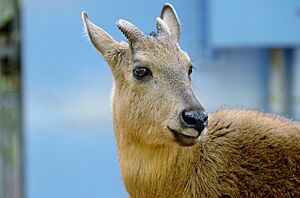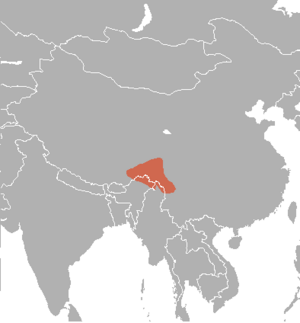Red goral facts for kids
Quick facts for kids Red goral |
|
|---|---|
 |
|
| Conservation status | |
| Scientific classification | |
| Genus: |
Naemorhedus
|
| Species: |
baileyi
|
 |
|
| Naemorhedus baileyi range | |
The red goral (Naemorhedus baileyi) is a special kind of wild goat. It's part of the Bovidae family, which includes animals like cows and sheep. You can find red gorals in mountainous areas of India, Tibet, and Myanmar. They usually live high up, between 1,000 and 2,000 meters (about 3,300 to 6,600 feet) above sea level. Sadly, their homes are shrinking, and they are also hunted, which puts them at risk.
Contents
Discovering the Red Goral
The name Naemorhedus comes from old Latin words. Nemus means "forest," and haedus means "young goat." So, it's like a "forest goat."
People first heard about a unique foxy-red goral back in 1912. These reports came from places like Southeast Tibet and Northeast Assam.
One of the very first mentions of these animals was in 1863. But it wasn't until 1961 that scientists officially recognized the red goral as its own distinct species.
Red gorals live only in the area where the borders of India, Myanmar, and China meet.
What Red Gorals Look Like
The red goral is a striking animal with bright, foxy-red fur. Its hair is long, soft, and shaggy. A thin, dark stripe runs down its back from its head to the tip of its tail.
Its legs are the same rich red color as its body. However, its belly is a lighter, buff color. The tail is black and quite short for a goral. But a long tuft of dark hair at the end makes it look longer.
How They Compare to Other Gorals
It's easy to tell the red goral apart from other gorals. All other goral types are usually grayish-brown. The red goral is also the smallest goral.
Both male and female red gorals have a pair of short, curved horns. Male horns are often longer and thicker than female horns. They usually measure between 7.5 and 16 centimeters (3 to 6 inches) long for both sexes.
Red gorals typically weigh between 20 and 30 kilograms (44 to 66 pounds). Their bodies can grow up to 100 centimeters (about 39 inches) long. Some evidence suggests females might be slightly larger than males, but the difference is very small.
Red Goral Behavior
Red gorals are most active during the day. They often graze on sunny mountain slopes. At night, they climb to high, hard-to-reach cliffs. They sleep there on sheltered ledges to stay safe.
They are amazing climbers and jumpers. If a predator comes near, they quickly run up cliffs to escape. Their main predators are jackals and leopards. Red gorals can jump over obstacles more than 1.8 meters (6 feet) high from a standing start!
Where They Live and Move
Red gorals live in mountainous areas and woodlands. You can find them in China and other nearby countries. These animals move up and down the mountains depending on the season.
In the summer, they stay in the higher parts of the forest. When winter comes, they move down to lower areas.
Sounds and Social Life
Red gorals are usually quiet animals. But during the breeding season, males make a sound like "zer - zer." Female red gorals also whistle when males get close.
Red gorals usually live alone. However, females are often seen with their latest baby. They only come together during mating season. Sometimes, you might see small groups of about three animals. These groups are usually a male, a female, and her baby, or a female with her babies from the past two years. This is because females usually have only one baby at a time.
What They Eat
Red gorals eat a variety of plants. Their diet includes lichens, grasses, stems, and leaves. Their most common food source is a type of lichen called Usnea.
Red Goral Reproduction
Red gorals breed from September to November each year. Female gorals can start having babies when they are about two years old. They become ready to mate around 1.5 years of age.
Males start showing mating behavior when they are about three years old. During mating season, males will follow females closely. They often sniff and lick the female to see if she is ready to mate.
If a female is not ready, she might run away or gently bump the male with her head. If she is ready, she will stand still as the male approaches. She signals this by raising her tail. Males often do a "lip curl" (called a Flehmen response) when they meet a female who is ready to mate.
Red Goral Habitat and Threats
The main home of the red goral is where the borders of India, Tibet, and Myanmar meet.
Scientists believe there are fewer than 10,000 red gorals left in the world. The actual number is probably much lower. In 1987 and 1988, it was estimated that only about 810 to 1,370 red gorals lived in Tibet. We don't know how many are in India and Myanmar, but they are likely not very common.
Why They Are in Danger
Hunting is a major threat to red gorals. They are one of the most hunted animals in their region. People hunt red gorals for their meat, skin, horns, legs, and gall bladders. The meat is often eaten by local people. The skin is sold to traders.
Another big problem is habitat loss. Forests are being cut down for farming and other uses. This destroys the homes of the red gorals.
Climate Change Impact
Red gorals live in mountainous areas, usually between 1,000 and 2,000 meters above sea level. Their environment is changing due to climate change. Traditionally, their climate has wet and dry seasons. But unusual dry spells are making it harder for red gorals to survive and reproduce.
Forests are also becoming broken up and smaller. This makes it harder for red gorals to find food and mates.
Helping the Red Goral
Because the number of red gorals is decreasing, the Shanghai Zoo started a special breeding program. They wanted to help prevent these animals from disappearing forever. The program began with seven wild red gorals. Over 22 years, they successfully raised 27 red gorals.
China is also trying to make and enforce laws against hunting red gorals. They are working to restore the natural places where these animals live. Some programs, like Chinese Geotourism, aim to earn money from wildlife while also protecting their homes. However, efforts in China often focus more on the endangered panda.
Red Goral Conservation Status
The International Union for Conservation of Nature (IUCN) lists the red goral as "vulnerable." This means they are at high risk of becoming endangered.
Experts like R. Harris and M. Festa-Bianchet reviewed the red goral's status in 2008. They found that the number of adult red gorals is still below 10,000. Their population continues to decline because of too much hunting. Because of this, their status has remained "vulnerable" since 1988.
See also
- Frederick Marshman Bailey


